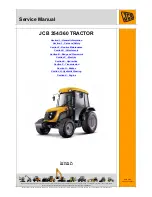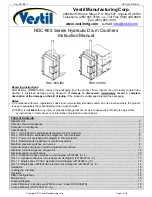
29
4.5. Tractor hydraulic system.
Your tractor is equipped with a hydraulic system providing accurate and sensitive control over a wide
range of operating conditions.
Two distinct systems are incorporated
1. Upper Link Draft Control.
2. Position Control.
The type of control selected will depend on the type of implement in use and the operating conditions.
Draft Control
is most suitable for mounted implements operating in the ground. Changes in the
working depth or soil resistance cause the draft loading on the implement to increase or decrease.
This change in draft loading is sensed through the top link of the three-point linkage and the hydraulic
system responds by raising or lowering the implement to restore the draft loading. In this way a
uniform draft load is maintained on the implement. The system responds to both upper link
compression and tension loads and is, thus, described as a double-acting system.
Position Control
provides accurate and sensitive control of implements such as sprayers, rakes,
mowers, etc., that operate above the ground. Position Control would not normally be used with
ground engaging equipment unless it is essential to maintain a constant depth regardless of the draft
load.
4.5.1. Hydraulic lift system.
The tractor has a dual lever system, i.e., separate levers for Draft and Position Control functions
(Figure. 3.2):
Draft Control lever (10 - Fig. 3.2) (next to the seat) is used to adjust the draft i.e. working depth
Position Control lever (9 - Fig. 3.2) (next to the mudguard ) is used to adjust the position/height
of the implement and lets you lift or lower the implement
Draft Control Operation
Move the Draft Control Lever in the quadrant to find the point near the centre where the lift links
neither raise nor lower. This is the neutral point.
Lower the implement into work using the Draft Control Lever. Push the Lever forward to increase the
draft loading. Pull rearwards to reduce the draft loading. In most circumstances, forward movement of
the Draft Control Lever will increase implement depth and rearward movement will reduce the depth.
Once set, the tractor hydraulic system will automatically adjust the implement depth to maintain an
even pull on the tractor and so reduce wheel slip to a minimum.
When lowering the implement into work push the Draft Control Lever down to the bottom of the
quadrant to ensure positive engagement of the implement in the ground then immediately raise the
Draft Control Lever until the required implement depth is achieved.
When the required implement working depth has been established, set the adjustable stop adjacent to
the Draft Control Lever to locate the position for repeated use. The Draft Control Lever may be eased
sideways to bypass the adjustable stop, if required.
A pressure sensitive feathering valve, installed within the hydraulic system, automatically regulates
the hydraulic oil flow to give smoother response to draft signals when using soil engaging implements.
In addition, some models have a manually operated flow control valve fitted to regulate the rate of
correction of the hydraulic system.
Tilt the Flow Control Valve knob, (18 - Fig. 3.2), rearward for the maximum rate of correction and
forward for the minimum correction rate. The rate of oil flow (correction) of the hydraulic system is
infinitely variable between these two points.
Pull the Draft Control Lever to the top of the quadrant to override the Flow Control Valve and raise the
implement quickly.
















































